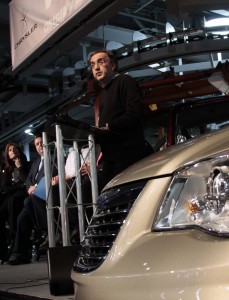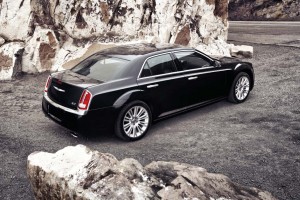With the help of the EPA, Chrysler plans to develop an unusual “hydraulic” hybrid system that could prove particularly effective at bumping up the fuel economy of its larger passenger cars and light trucks.
The maker intends to have the new technology ready to demonstrate by 2012, about the same time it will begin rolling out a new, more conventional battery-electric hybrid system that will first appear on the new full-size 300 sedan and various Chrysler minivans.
“Hydraulic hybrid vehicle technology is one more promising path worth pursuing in the effort to reduce our carbon footprint, and we are excited to partner with the EPA to push forward on this track,” said Chrysler CEO Sergio Marchionne, during an appearance at the Environmental Protection Agency lab in Ann Arbor, Michigan, where he met with EPA Director Lisa Jackson.
Hydraulic hybrid systems are not entirely new, having found use in industrial applications, including large delivery trucks. Where conventional automotive hybrid systems recapture energy normally lost during braking, storing it in an onboard battery pack, hydraulic hybrids use a pump to store energy in a special accumulator, at pressures of up to 5,000 psi.
Paired with a compact, 2.4-liter inline four-cylinder engine, the system would provide additional power during acceleration and, under some conditions, could drive the vehicle entirely on its own, much like the battery drive in a so-called “full hybrid,” like the Toyota Prius, can operate solely on battery power for limited runs.
Other makers, including Ford, have explored the use of hydraulic hybrids for larger vehicles, though whether the technology will ultimately prove effective is still uncertain. And so, for the near-term, Chrysler is developing a new battery-electric drivetrain that will first see production next year.
The hybrid 300 sedan will be first to market, Marchionne revealed during an event at the Chrysler minivan plant in Windsor, Ontario, while the vans will adopt the gasoline-electric technology in 2013, when an all-new generation of people movers comes to market.
Company officials indicated hybrid drivelines will later migrate to other models as Chrysler drives down the cost of producing the technology.
Chrysler has had a tepid commitment to hybrid propulsion, until now. While still a subsidiary of the former DaimlerChrysler AG, the U.S. maker partnered with General Motors and, later, BMW, on the development of a so-called two-mode gas-electric system. But that technology proved expensive and delivered questionable benefits on models such as the Chrysler Aspen SUV, which has since been pulled from the market.
Part of the problem, for Chrysler, was the lack of in-house engineering capabilities as the maker was steadily downsized, first by the Germans and then by Cerberus, which purchased the company from Daimler and then drove it into bankruptcy.
With its dependence on larger cars, minivans, pickups and SUVs, Chrysler is struggling to meet the 35.5 mpg fuel economy standard set in place by federal regulators for 2016. It will be even more challenged going forward, the EPA giving serious consideration to rules that would bump the Corporate Average Fuel Economy, or CAFE, standard to somewhere around 62 mpg by 2025.
Most makers are expected to rely on battery-based propulsion systems to help them meet the upcoming mileage hurdles, though improved gasoline – and even diesel – technology will also be part of the powertrain mix.
Chrysler is expected to develop not just hybrids but basic assist systems, such as Stop/Start technology — which temporarily shuts off a vehicle’s engine instead of idling, reducing fuel consumption by up to 10% — as well as plug-in hybrids and full battery-electric vehicles, or BEVs.
The maker does produce a line of so-called Neighborhood Electric Vehicles, or NEVs, through its GEM subsidiary, but a program aimed at developing plug-ins and BEVs was scuttled as the maker plunged into its 2009 bankruptcy.
Chrysler’s Italian partner, Fiat, will roll out a battery-based version of its little Fiat 500 model, next year, but there have been no plans made public about Chrysler offerings – even though Marchionne has made the U.S. partner in the trans-Atlantic alliance the lead in its electrification efforts.
That decision may reflect the potential for generating financial support from the U.S. government, which still owns a chunk of Chrysler as a result of its 2009 bailout program.
While competitors have expanded the use of hybrid technology to include crossovers and SUVs, such as the Lexus RX400h and the Ford Escape Hybrid, Chrysler may be on track to become the first automaker to hybridize a minivan.
That underscores the continuing importance of models like the Chrysler Town & Country to the maker credited with launching the first modern people mover a quarter century ago. Though it has lost ground to import competitors like the Honda Odyssey and Toyota Sienna, and watched as the segment has shrunk to barely half its once-formidable peak, Chrysler is still the minivan leader.
And, “We’re not going to give up one inch of territory in domination of this segment,” CEO Marchionne declared at the Windsor minivan plant.
The maker has made significant modifications to its two remaining models for 2011, but it will make even more substantial changes when the next-gen vans debut. The Town & Country will move more up-market, according to company officials, while the Dodge Caravan may shift to a smaller footprint, reflecting the continued downsizing of the American automobile.
An all-new platform will be used for the new models, and in keeping with industry trends, that “architecture” will be flexible enough to share with other products that will be added to the Chrysler portfolio – possibly along with models that will be sold by some of Fiat’s various global brands.



The Common-Rail and the MultiAir/UniAir/TwinAir tech, both inventions of Fiat, prove that a hydraulic piping might turn out more efficient than the electrical cables and the batteries.
As simple the mathematics is for Fiat Power Train (FPT), as exotic they appear to the rest OEM’s.
Fiat’s modern Common-Rails can deal with over 2,000 bars (30,000 psi); if we can make the pipelining of the hydraulic-hybrid (HYDRID) capable to manage one forth of this pressure, the resulting efficiency is better than any Prius.
A good HYDRID takes an efficient hydraulic system and a fuel efficient, lightweight, vibration free engine.
Something like this: http://www.pattakon.com/pre/PRE19.exe ? (at http://www.pattakon.com/pattakonOPRE.htm )
Manousos Pattakos